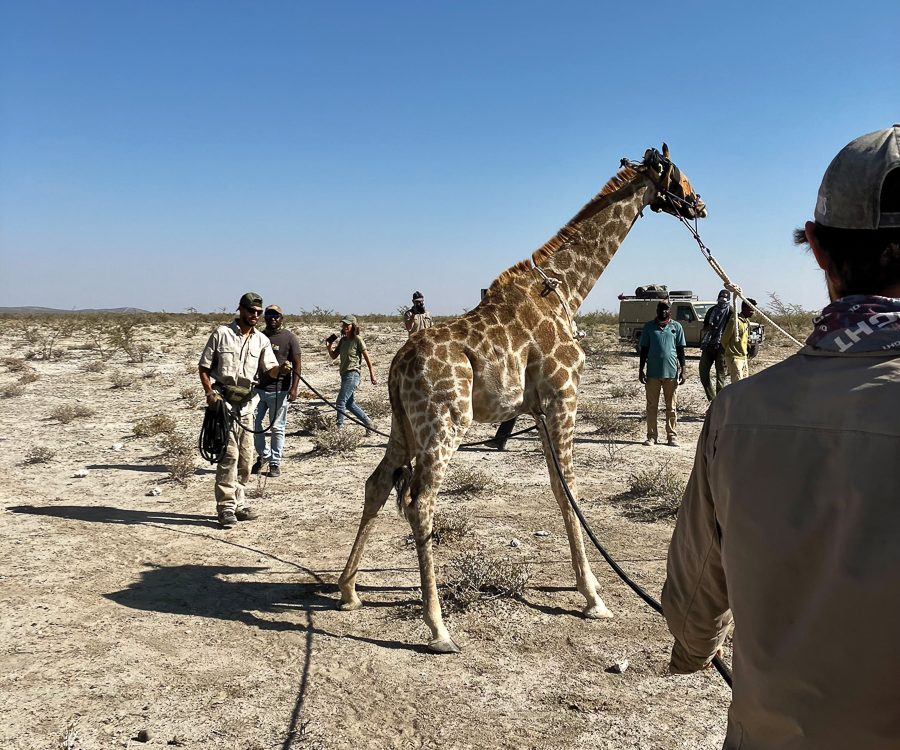Events | June 2015
May 20, 2015Conservation | Lichen Fields Protection Project
May 22, 2015Making an uneasy co-existence easier – leopards and farmers
Auas Oanob Conservancy and the Leibniz Institute for Zoo and Wildlife Research (IZW)
By Vera Menges & Joerg Melzheimer | Main photo by Bernd Wasiolka
Namibians are known for their love of beef and their commitment to conservation. These two passions are not mutually exclusive. The co-existence of predators and livestock on farmlands is practiced throughout our country. However, when predators deplete livestock numbers, there is conflict and the best way of dealing with it is by making informed choices.
What makes the study of leopards south of Windhoek in the Auas Oanob Conservancy so interesting, is that farmers are taking the lead. They initiated the study and are collaborating with researchers and the Ministry of Environment and Tourism in their quest to gain scientific information on leopards sharing Namibian farmland. This information will be key to improving farm and herd management and ultimately reducing human-wildlife conflict.
By fitting GPS collars to a number of leopards and analysing leopard movements over time, the project’s research activities and their management implications include the following:
Home range size
Studying home range size will provide a sound understanding of the average area single leopards cover and, on average, how long an individual leopard stays in a particular area. This information will help farmers in understanding how leopards move through their land and if problems with stock raiding are do occur, they will be better able to identify the exact problem animal.
Farmers can adopt their management strategies according to the findings and preferably use or avoid certain areas for grazing herds with younger calves.
Habitat preference
This part of the study will provide information on whether or not leopards prefer certain habitat types, how habitat is structured and how much time a leopard is spending in a particular habitat type.
If leopards spend significantly more time in certain habitat types, farmers will not use this habitat type for grazing of cattle herds with younger calves.
Feeding habits
Feeding habits and prey preferences are another critical factor in understanding the farmer-leopard conflict. The key question is: are leopards opportunistic hunters which randomly take livestock, or have certain individuals learned to specialise in hunting livestock?
If it turns out that certain leopards do specialise in hunting livestock, we could specifically target these problem animals to relocate them. They could be part of a well-organised trophy hunt that would generate some revenue for various stakeholders.
“Co-existence between humans and wildlife is not a romantic and “green” notion; it is critical to our country’s economy. The tourism industry is vital to our country and Namibia’s wildlife. Big cats, like leopards, are one of our greatest attractions”, says Jörg Melzheimer
Improving farm management, reducing losses and thereby promoting the coexistence of leopards on commercial farmland will be beneficial to the entire country. In Namibia, the livelihood of many people depends on livestock farming. We need to reduce financial losses through better management of our livestock herds. Only then can co-existence of leopards and humans be ensured.
Fast Facts
- Scientific name: Panthera pardus
- Solitary, elusive carnivore
- Mainly nocturnal
- Very good climber and swimmer
- Often hides prey in trees to avoid scavengers (usually in areas with lions and/or spotted hyenas). In areas without lions and/or spotted hyenas, prey is mostly dragged under or into bushes
- Hunting strategy: stalker/pouncer
- Vast range of prey
- Smallest prey found: dung beetle
- Largest found: giant eland
- Average prey size: 23 kg
- Marking with scent/faeces/scratching
- Territorial (both sexes)
- Reproductive behaviour: associates for mating for the duration of a few days
- Reproductive age: >2 years
- No particular breeding season
- Female without cubs goes into estrus approximately every 46 days
- Gestation period: 90-105 days
- 1-3 cubs (3 cubs are very rare)
- At about six weeks the cubs may be left alone for up to 36 hours while the mother is hunting
– duration approximately 7 days
– cubs leave hide/den
– are able to climb trees
– start eating meat (but still nurse) - Offspring is independent at approximately 22 months
About the Team
- Joerg Melzheimer Spatial ecologist: Initiator of the project, project leader, immobilising of animals, communication with stakeholders.
- Vera Menges PhD student: Handling of animals, analysis of spatial data gained through collars, collection and analysis of data regarding feeding behaviour via GPS data, communication with stakeholders (contact person regarding progress of the project and updates on data, talks at conservancy meetings).
- Dirk Bockmühl Technical assistant: trapping of leopards.
- Ruben Portas Research assistant: involved in trapping of the leopards, assistance during the immobilizations and aerial tracking of collared animals.
- Dr Bettina Wachter Senior researcher: senior scientific adviser to the project.
- Dr Bernd Wasiolka Animal ecologist: aerial tracking.
- Dr Miha Krofel Senior reearcher: scienfitic adviser to the project






